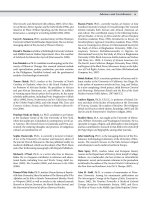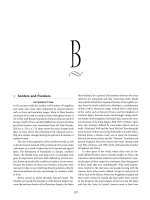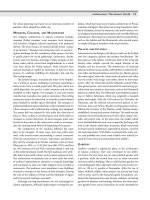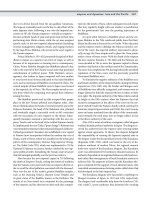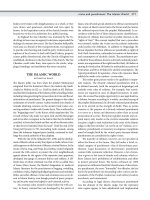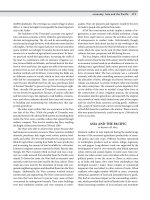Encyclopedia of society and culture in the medieval world (4 volume set) ( facts on file library of world history ) ( PDFDrive ) 837
Bạn đang xem bản rút gọn của tài liệu. Xem và tải ngay bản đầy đủ của tài liệu tại đây (39.08 KB, 1 trang )
810 pandemics and epidemics: The Americas
another. When people afflicted with these diseases arrived in
the New World—and it would only take one—they arrived
on what epidemiologists call “virgin soil,” meaning that the
immune systems of native peoples were not equipped to resist
European diseases.
These scientists do assert, however, that surviving native
accounts of long-lived people who enjoyed good health in an
American paradise are not entirely accurate. While widespread epidemics were not common, periodic outbreaks of
disease, often made worse by drought and famine, were common in the centuries before the arrival of Europeans. Further,
these scientists dispute the assertion that pre-Columbian
Americans lived long lives, pointing to evidence that suggests
that infant mortality may have been as high as 40 percent,
and life expectancy for those who survived infancy was in
the 20s for men and perhaps less for women. Although many
deaths resulted from warfare and traumatic accidents, others
were caused by disease.
People who remained hunters and gatherers were subject to many bacterial infections, including salmonellosis and
shigellosis, and parasitic infections, including hookworms,
tapeworms, pinworms, and whipworms. The bacterial infections cause acute illness in the digestive system, often leading to death. Salmonellosis was more common among North
American natives, while shigellosis was more common in
tropical regions. Although most parasitic infections are not
in themselves fatal, they produce malaise and weakness that
allow other infections to take over and possibly lead to death.
Two other bacterial diseases, staphylococcus and streptococcus infections, were also prevalent. These often lead to fatal
diseases such as pneumonia, meningitis, and endocarditis.
Evidence of protozoan infections like amebiasis, giardiasis,
and toxoplasmosis has been found from the medieval era and
likely reached epidemic proportions in some communities.
Some illnesses were endemic to the New World, including leishmaniasis and trypanosomiasis, which are parasitic
diseases common in tropical areas. New World spotted fever
was common, especially in North America. Sandflies transmitted bartonellosis, sometimes called Carrión’s disease, in
the mountain valleys of South America. Again, most of these
were not fatal but became fatal during times of famine or by
making the victim susceptible to other illnesses, especially
pneumonia, one of the most common killers in the pre-Columbian Americas. Nonetheless, tick-borne relapsing fever
may have had a mortality rate of up to 50 percent. While the
leading causes of death among infants and children were
pneumonia, tuberculosis, shigellosis, salmonellosis, amebiasis, and giardiasis, adults were more likely to succumb to
leishmaniasis, trypanosomiasis, bartonellosis, leptospirosis,
and relapsing fever.
It might be assumed that agriculture improved the
health of Native Americans by providing a more predictable
food supply, but that assumption is false. Archaeologists have
shown that the physical stature of Americans declined after
the advent of agriculture and that people who were slower to
adopt agriculture remained taller for a longer period; both
findings suggest that farmers generally had a poor diet.
Throughout the Americas the reliance on one or two staple
crops, particularly corn, led to significant dietary deficiencies, including a lack of protein, a lack of niacin (which causes
a disease called pellagra), and a lack of iron (which causes
anemia). Again, these conditions do not become epidemics because they are not transmitted from person to person.
However, they were widespread illnesses that led to short life
spans, aborted fetuses, and high mortality rates. Moreover,
the ill person was likely to be more susceptible to an infectious disease like pneumonia that could spread throughout a
village and lead to an epidemic.
Settled agricultural communities in the Americas in
pre-Columbian times experienced “crowd diseases” in much
the same way Europeans did. As people moved into villages
and villages grew into cities, illness caused by poor sanitation, contaminated food and water, and crowded conditions became common. This occurred particularly in times
of war, when people fled to cities for protection. A major
cause of death was acute respiratory infection. Also common was tuberculosis, which was widespread throughout
North America and in the highlands of South America. Respiratory tuberculosis often led to pneumonia, which was
frequently fatal. Surviving tissue samples strongly suggest
that many people suffered from pneumonia on more than
one occasion. Another common respiratory infection was
blastomycosis, which is caused by a fungus that lives in the
soil and was especially prevalent in tropical and subtropical
regions among people who worked the land and thus were
exposed to the fungus.
A topic of some controversy is whether outbreaks of typhus occurred before the arrival of Europeans. The conventional theory is that explorers and traders from Spain and
elsewhere in the Old World brought typhus to the New World.
However, some historians believe that evidence points to typhus existing in the New World before the European ships
began arriving. There are two types of typhus: endemic typhus is spread by fleas, and epidemic typhus is spread by lice.
Hunter-gatherer cultures probably experienced outbreaks
of endemic typhus, but because they did not live in crowded
conditions, the outbreaks probably did not turn into widespread epidemics. However, as people moved into cities and
lived in more crowded and unsanitary conditions, epidemic
typhus may have become more common.

